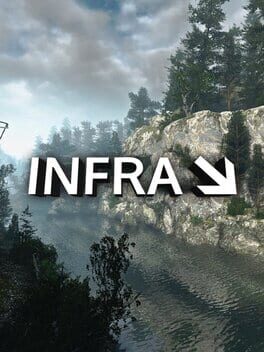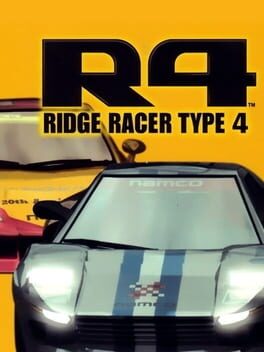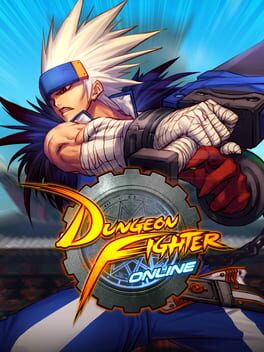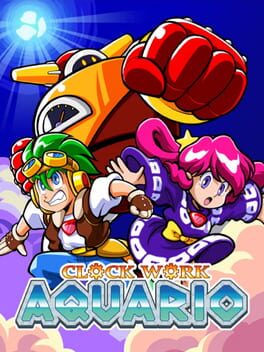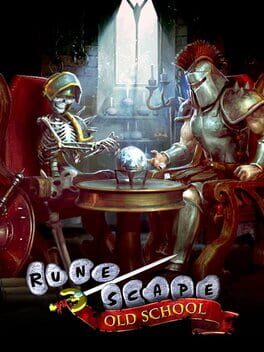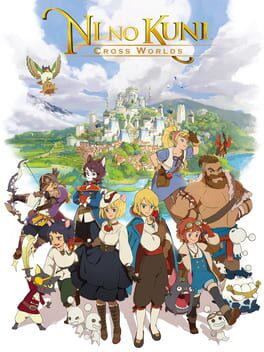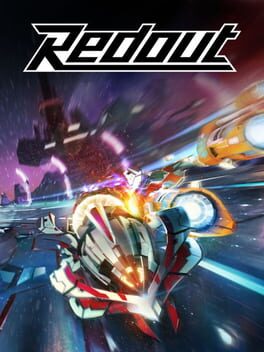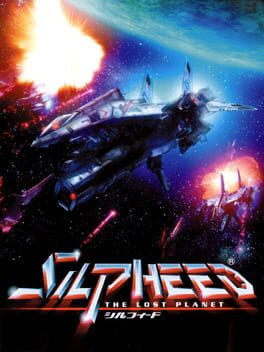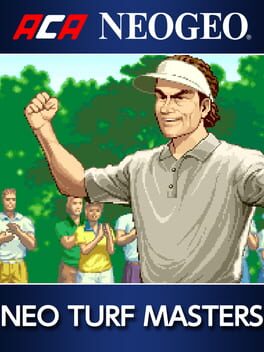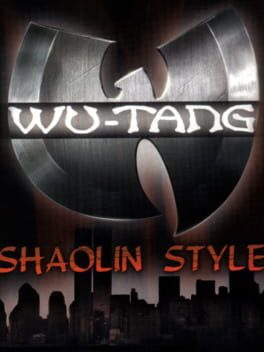BeachEpisode
S&P:SS is a rock solid rail shooter, albeit a much more crowd-pleasing affair than its predecessor, which was akin to an iron-deficient recollection of End of Evangelion as reflected through the lens of a fever dream. Star Successor takes a more generalised approach to the rail shooter formula, with fewer gimmicky segments and an easily digestible rosary of stages that begin & end in the ways you could predict. Being the sole game Yasushi Suzuki has expressly worked on as Art Director, their calibre of style and pageantry in Star Successor is absolutely off the hook - I doubt I’m being controversial in my assessment of their skill as an artist being some of the most refined aesthetic sensibilities to have blessed the medium yet. The level of planning here for boss variety is particularly impressive, I’m convinced the bones are here for a knockout boss rush title. Huge fan of the guy that turns into dolphins that bounce beachballs and jump through hoops which all become dangerous projectiles. As a whole, I’m fairly convinced that this game is more smartly designed overall than its predecessor, as the consistency with which it dolls out mindful bullet patterns that compound effortlessly on the mental stack, and contextualisations for the multi-layered hazards are nothing short of impressive.
Where things turn sour for me is in the dodgy hitboxes and how drawn-out the stages feel, as the excursions buckle under their padding and turn into fairly languid drifts across locales and enemy swarms. Nothing lasts as long as I’d feel they should, and I repeatedly find myself sighing with fatigue when another mob corridor is punctuated with another miniboss as opposed to a more meaningful perspective or narrative shift. Credit where it’s due, it’s ultimately a good thing that Treasure took a very different approach for this sequel, one that effectively showcases the ways their aesthetic and design tenets matured in the span of a decade. My preference for the original is just a consequence of it winning me over in the battle of appeals - in the personal and artistic fulfillment I gain from “imperfect” games that scan as confused little miracles. Star Successor is solid, but far too articulately concocted to give me any real sense of impact - feeling more like a product, and therefore more prone to being scrutinised over the mechanical minutia. Ultimately a miss for me, but a stunning little simulacrum of a game I still find otherworldly.
Where things turn sour for me is in the dodgy hitboxes and how drawn-out the stages feel, as the excursions buckle under their padding and turn into fairly languid drifts across locales and enemy swarms. Nothing lasts as long as I’d feel they should, and I repeatedly find myself sighing with fatigue when another mob corridor is punctuated with another miniboss as opposed to a more meaningful perspective or narrative shift. Credit where it’s due, it’s ultimately a good thing that Treasure took a very different approach for this sequel, one that effectively showcases the ways their aesthetic and design tenets matured in the span of a decade. My preference for the original is just a consequence of it winning me over in the battle of appeals - in the personal and artistic fulfillment I gain from “imperfect” games that scan as confused little miracles. Star Successor is solid, but far too articulately concocted to give me any real sense of impact - feeling more like a product, and therefore more prone to being scrutinised over the mechanical minutia. Ultimately a miss for me, but a stunning little simulacrum of a game I still find otherworldly.
2016
“Whatever he’s planning, it’s going to happen, and I don’t want to be here when it does. If there’s one thing I’m sure of; everything’s about to fall apart”.
A couple days ago, I was calmly and cooly lamenting the way Half Life 1’s cinematic setpieces still remain somewhat unique through to today. There’s something I find incredibly cathartic about cataclysmic things happening to a gigantic facility while the player Mr Bean’s their way through falling platforms and rubble, all the while gormlessly operating critically important, high-powered machinery you have no qualifications for. Everyone wants their FPS to have a shotgun with lots of recoil or something, but I want an elevator shaft sequence with massive casualties.
INFRA is a rough-around-the-edges little anomaly of a game - if it isn’t outsider art, it skirts dangerously close. It’s just so rare for a title to lean so far into its own neuroses alongside such genuinely impressive production values.
Tasked, as a structural analyst, to do a routine survey of the crumbling water treatment facilities on the outskirts of the fictional city of Stalburg, there is little more for the player to do mechanically than take photographs of OSHA violations and flick switches. Even still, the average first playtime of INFRA is 22 hours long. An oftentimes painful linear first-person adventure where the common roadblock is the odd wildly cruel puzzle and level design. It truly begs belief, the shit they make you do in this to earn a crumb of progress.
I really do love the good majority of what this game accomplishes - there’s an engrossing sense of scale on the journeys between the puzzles. Though the game is linear, there is a lot of wriggle room for alternating paths and solutions to key events, all the while the set designers filled every nook and cranny with surprisingly mindful details and assets that make the city feel lived-in and rewarding to poke around. It’s even replete with intense large-scale destructive setpieces that remind me of something like Disaster Report, and the player character's dialogue has that tired in-over-his-head everyman energy that I luvv. Navigation requires careful deliberation as you have to scan the environment for the most subtle nudges in the right direction; finding keys, notes containing passwords, manuals explaining how to operate machinery. Dizzyingly many things here are purely optional and only affect your playthrough way down the line, if at all.
Where INFRA loses me is in how rotely demanding it can be. The kinds of puzzles here are these legitimately tricky logic tests that tend to be sprawled out over a large playable area - often obscured by too much detail and not-enough lighting - meaning that to even test out a hypothesis, the player has to do a not-insignificant amount of travel between inputs. The developers have this undeniable keen interest in civil engineering, the way these facilities and utilities are connected to one another in a grand network of city planning and infrastructure…… but it’s the sole thing that extends the playtime, and it fucking wore me down. There’s a grand conspiracy element to the game’s overarching story and I could hardly pay it any mind because I just wanted the water on the floor to stop electrocuting me. It wasn’t until the game entered its closing act where I finally felt as though I had clocked to the designer’s puzzle logic. I wanted INFRA to kill its darlings, cull extraneous sections and give me more simple problems to solve - but the game’s more interesting with the sheer friction it poses. Imagine you turned the difficulty of Half Life 1 to the max, only for it remove all of the enemies and guns, & make Black Mesa more annoying instead.
While the game routinely lost its balance on the knife’s edge between demanding and frustrating, I found myself completely enamoured by the way Loiste Interactive hyperfocuses on the spectacle, genuine lived-in immersion, of the decaying infrastructure of the fictional city of Stalburg. Allegedly inspired by watching a documentary on the crumbling network of civil engineering that the USA relies heavily on, INFRA is a game about corruption and decay. It’s a crude image, one of vainglorious despots causing corporate neglect to eat away at the infrastructure we rely on, cataloguing the rebar and cabling that protrudes the crumbling concrete like scabs, but it’s truuu.
INFRA ain’t a game for everyone, but there’s a lot here for folk with saintly patience to appreciate. If you do give it a miss, please at the very least say “tyvm :3” to the overpass you drive under for being kind enough not to fall directly on top of you. It’s very tempted, I’d be too.
A couple days ago, I was calmly and cooly lamenting the way Half Life 1’s cinematic setpieces still remain somewhat unique through to today. There’s something I find incredibly cathartic about cataclysmic things happening to a gigantic facility while the player Mr Bean’s their way through falling platforms and rubble, all the while gormlessly operating critically important, high-powered machinery you have no qualifications for. Everyone wants their FPS to have a shotgun with lots of recoil or something, but I want an elevator shaft sequence with massive casualties.
INFRA is a rough-around-the-edges little anomaly of a game - if it isn’t outsider art, it skirts dangerously close. It’s just so rare for a title to lean so far into its own neuroses alongside such genuinely impressive production values.
Tasked, as a structural analyst, to do a routine survey of the crumbling water treatment facilities on the outskirts of the fictional city of Stalburg, there is little more for the player to do mechanically than take photographs of OSHA violations and flick switches. Even still, the average first playtime of INFRA is 22 hours long. An oftentimes painful linear first-person adventure where the common roadblock is the odd wildly cruel puzzle and level design. It truly begs belief, the shit they make you do in this to earn a crumb of progress.
I really do love the good majority of what this game accomplishes - there’s an engrossing sense of scale on the journeys between the puzzles. Though the game is linear, there is a lot of wriggle room for alternating paths and solutions to key events, all the while the set designers filled every nook and cranny with surprisingly mindful details and assets that make the city feel lived-in and rewarding to poke around. It’s even replete with intense large-scale destructive setpieces that remind me of something like Disaster Report, and the player character's dialogue has that tired in-over-his-head everyman energy that I luvv. Navigation requires careful deliberation as you have to scan the environment for the most subtle nudges in the right direction; finding keys, notes containing passwords, manuals explaining how to operate machinery. Dizzyingly many things here are purely optional and only affect your playthrough way down the line, if at all.
Where INFRA loses me is in how rotely demanding it can be. The kinds of puzzles here are these legitimately tricky logic tests that tend to be sprawled out over a large playable area - often obscured by too much detail and not-enough lighting - meaning that to even test out a hypothesis, the player has to do a not-insignificant amount of travel between inputs. The developers have this undeniable keen interest in civil engineering, the way these facilities and utilities are connected to one another in a grand network of city planning and infrastructure…… but it’s the sole thing that extends the playtime, and it fucking wore me down. There’s a grand conspiracy element to the game’s overarching story and I could hardly pay it any mind because I just wanted the water on the floor to stop electrocuting me. It wasn’t until the game entered its closing act where I finally felt as though I had clocked to the designer’s puzzle logic. I wanted INFRA to kill its darlings, cull extraneous sections and give me more simple problems to solve - but the game’s more interesting with the sheer friction it poses. Imagine you turned the difficulty of Half Life 1 to the max, only for it remove all of the enemies and guns, & make Black Mesa more annoying instead.
While the game routinely lost its balance on the knife’s edge between demanding and frustrating, I found myself completely enamoured by the way Loiste Interactive hyperfocuses on the spectacle, genuine lived-in immersion, of the decaying infrastructure of the fictional city of Stalburg. Allegedly inspired by watching a documentary on the crumbling network of civil engineering that the USA relies heavily on, INFRA is a game about corruption and decay. It’s a crude image, one of vainglorious despots causing corporate neglect to eat away at the infrastructure we rely on, cataloguing the rebar and cabling that protrudes the crumbling concrete like scabs, but it’s truuu.
INFRA ain’t a game for everyone, but there’s a lot here for folk with saintly patience to appreciate. If you do give it a miss, please at the very least say “tyvm :3” to the overpass you drive under for being kind enough not to fall directly on top of you. It’s very tempted, I’d be too.
1998
Can you feel the heat?
When the tires kiss the street
Move into the beat
Ever since I learned about occlusion culling, a technique deftly handled by Naughty Dog with their first PlayStation 1 title, Crash Bandicoot, my appreciation for the more graphically stellar titles for the system was granted a new shade. It helped offer me a frame of reference (granted, of one of the more extreme use cases) for the necessity to obscure unneeded geometry to save what precious few resources the console could afford - as well as giving me something to mull over whenever I play a 3D PS1 game that looks suspiciously good. Much akin to Crash Bandicoot, racing games benefit from what is essentially a densely curated linear track. With limited camera movement, every attainable viewing angle can be accurately poured over by the designers, letting them carefully weigh up exactly how much they can get away with at every meter of game space. This is very apparent in visually stunning racing titles like Wipeout 3, Colin McRae Rally 2.0, and Need for Speed: High Stakes; their tracks are glutted with turns, verticality and obstacles that exist to obscure as much model pop-in as possible, and offer a new piece of visual stimuli at every turn. This has a knock-on effect for how these tracks are actually driven on, too. Track designers are by necessity discouraged from long straightaways where the world noticeably phases into existence, and instead ensure that the player has very little if any downtime from cornering, maintaining a thrilling tempo that only stops when the chequered flag is waved. I say all this, because I really do miss the era where racing games were these hardware-defying explosions of style and skill, with enough big-money backing to allow the designers to let their perfectionism and neuroses get tangled in the engine’s crankshaft. I can only go in a straight line down a massive realistic unreal engine map for so long.
Anyway. Ridge Racer Type 4 is a Swiss watch. One of very, very few games I’d describe as “meticulous”. Every one of its moving parts serves a key purpose in its grand design. Its mechanisms are the result of painstaking consideration for the most minute details. Built to last, and never lose its sheen. The only game my dad likes (real). It all just moves & breathes with this air of confidence and romance, exemplified by the way the penultimate setpiece is the final lap taking place at the exact turn of the millennium - a genuinely affecting gesture to barrel through doubt and seize your future by any means.
One thing I’m particularly taken by is the overall stylistic presentation of Type 4. Among the first things you see upon loading it up are the game’s signature tail/headlight afterglows leaving trails across the screen. The preamble at the start of this review was for no reason other than the fact that R4 actualises the PS1. Its environments use every trick in the book with a healthy serving of incredible models & baked-in textures to make the world feel rich beyond the scope of the road. The game’s UI alone is worth studying for its consistent use of very few colours, empty-space and minimalist decoration (every game needs a "PLEASE" in the corner at all times). In establishing a universe that seemingly exists solely for the purpose of racing fictional cars around the fictional Ridge City, the developers at Namco have populated the series with a mountain of logos, icons, banners, signs, patterns, manufacturers, liveries and colour palettes. They work to establish the curves, hills and tunnels as very real places with a history all their own. How did Wonderhill get its name? Why is it called Shooting Hoops? Where are these places in Ridge City and how do they fit into the Ridge Racer universe?
Look at the Helter Skelter track’s logo, for instance. One of the things I enjoy about this logo is its deceptively simple construction that results in a complex visual illusion of sorts. Essentially, the structure is a series of circles that reduce in size from top to bottom. The circles do not change shape in the slightest, only in scale, and by removing their intersections and filling in some minor spaces to complete the shape, is this illusion achieved. It harkens to the track’s multi-levelled nature, conveying a sense of movement as you rapidly weave through overpasses and underground tunnels w/ the ferocity of a hurricane.
The whole game is like this. A veritable archive of mindful audio, visual and game design, of weapons-grade artistic talent. Beyond aspirational and genuinely medium affirming.
When the tires kiss the street
Move into the beat
Ever since I learned about occlusion culling, a technique deftly handled by Naughty Dog with their first PlayStation 1 title, Crash Bandicoot, my appreciation for the more graphically stellar titles for the system was granted a new shade. It helped offer me a frame of reference (granted, of one of the more extreme use cases) for the necessity to obscure unneeded geometry to save what precious few resources the console could afford - as well as giving me something to mull over whenever I play a 3D PS1 game that looks suspiciously good. Much akin to Crash Bandicoot, racing games benefit from what is essentially a densely curated linear track. With limited camera movement, every attainable viewing angle can be accurately poured over by the designers, letting them carefully weigh up exactly how much they can get away with at every meter of game space. This is very apparent in visually stunning racing titles like Wipeout 3, Colin McRae Rally 2.0, and Need for Speed: High Stakes; their tracks are glutted with turns, verticality and obstacles that exist to obscure as much model pop-in as possible, and offer a new piece of visual stimuli at every turn. This has a knock-on effect for how these tracks are actually driven on, too. Track designers are by necessity discouraged from long straightaways where the world noticeably phases into existence, and instead ensure that the player has very little if any downtime from cornering, maintaining a thrilling tempo that only stops when the chequered flag is waved. I say all this, because I really do miss the era where racing games were these hardware-defying explosions of style and skill, with enough big-money backing to allow the designers to let their perfectionism and neuroses get tangled in the engine’s crankshaft. I can only go in a straight line down a massive realistic unreal engine map for so long.
Anyway. Ridge Racer Type 4 is a Swiss watch. One of very, very few games I’d describe as “meticulous”. Every one of its moving parts serves a key purpose in its grand design. Its mechanisms are the result of painstaking consideration for the most minute details. Built to last, and never lose its sheen. The only game my dad likes (real). It all just moves & breathes with this air of confidence and romance, exemplified by the way the penultimate setpiece is the final lap taking place at the exact turn of the millennium - a genuinely affecting gesture to barrel through doubt and seize your future by any means.
One thing I’m particularly taken by is the overall stylistic presentation of Type 4. Among the first things you see upon loading it up are the game’s signature tail/headlight afterglows leaving trails across the screen. The preamble at the start of this review was for no reason other than the fact that R4 actualises the PS1. Its environments use every trick in the book with a healthy serving of incredible models & baked-in textures to make the world feel rich beyond the scope of the road. The game’s UI alone is worth studying for its consistent use of very few colours, empty-space and minimalist decoration (every game needs a "PLEASE" in the corner at all times). In establishing a universe that seemingly exists solely for the purpose of racing fictional cars around the fictional Ridge City, the developers at Namco have populated the series with a mountain of logos, icons, banners, signs, patterns, manufacturers, liveries and colour palettes. They work to establish the curves, hills and tunnels as very real places with a history all their own. How did Wonderhill get its name? Why is it called Shooting Hoops? Where are these places in Ridge City and how do they fit into the Ridge Racer universe?
Look at the Helter Skelter track’s logo, for instance. One of the things I enjoy about this logo is its deceptively simple construction that results in a complex visual illusion of sorts. Essentially, the structure is a series of circles that reduce in size from top to bottom. The circles do not change shape in the slightest, only in scale, and by removing their intersections and filling in some minor spaces to complete the shape, is this illusion achieved. It harkens to the track’s multi-levelled nature, conveying a sense of movement as you rapidly weave through overpasses and underground tunnels w/ the ferocity of a hurricane.
The whole game is like this. A veritable archive of mindful audio, visual and game design, of weapons-grade artistic talent. Beyond aspirational and genuinely medium affirming.
Wanted to give this game a shake out of sheer curiosity about contextualising the upcoming Dungeon Fighter Duel fighting game. There is a surprising amount of variety to the myriad playable classes, if the preview videos in the character creator screen are anything to go off - each subclass is replete with heavily stylised animations and unique playstyles, it seems genuinely a little sick when things get going. Not to mention I had to wonder how an "MMO beat em up" even worked, if at all. Most immediately striking is the sprite artstyle, as busy & clashing as a day at the races @ Maplestory or Gaia Online. Consider me a cow for this kind of tacky maximalism.
But like. Somehow I got autobanned halfway through making a character. Don't know what kind of cowboy anti-cheat they're running over there but my ass couldn't even leave the station lol - and it seems many of the Steam reviews are people raving about the same issue. Could it be because I chose the subclass the game beautifully and artfully named "Geniewiz"?? Hopefully the fighting game kicks you to the main menu the moment you pick your character from the roster for the authentique xperience!!!
But like. Somehow I got autobanned halfway through making a character. Don't know what kind of cowboy anti-cheat they're running over there but my ass couldn't even leave the station lol - and it seems many of the Steam reviews are people raving about the same issue. Could it be because I chose the subclass the game beautifully and artfully named "Geniewiz"?? Hopefully the fighting game kicks you to the main menu the moment you pick your character from the roster for the authentique xperience!!!
2021
One of the more worthwhile candidates from recent years for a Noclip documentary. I can't help but want to peer behind the veil and see how they published and repaired a bad dump of a missing & presumed dead arcade project from 1992. Clockwork Aquario hit my aesthetic taste just right, so I spent a couple of years after hearing of it praying to jeezus for a chance to see it in action; it's a rare treat for something like this to come out at all.
Not much to write home about here. It's okay! Studio Westone's DNA is plenty apparent in Clockwork Aquario's design, very much feeling like a Wonder Boy game with an arcade platformer spin. Chunky sprites and heft to the character movement as you break and throw stuff. It does some fun stuff with its scoring system that encourages greed and dastardly deeds, but on the whole, it's an alarmingly easy game. Vague memorisation of level layouts in its short 20-min runtime will have you chugging invincibility powerups effortlessly, and it even gives you them during boss fights which totally trivialises them. The difficulty settings at the frontend of this release sadly only seem to change your continue count, rather than anything gameplay oriented... vvvv little meat on this bone. Clockwork Aquario particularly shines in its 2-player co-op - some much-needed chaos is filled in by you bouncing off of / getting thrown around the screen by your partner.
Loathe as I am to admit, the urchins at the ""location test" (toesucker convention) were probably spitting a few kernels of truth in their assessment that ultimately buried this game for thirty years; Clockwork Aquario only barely works - and why would I pour coins into a middling platformer when the fightgame scene is blowing up? It's, on the whole, an excellent thing that the gaming landscape has shifted to a point where it's viable to restore and publish niche treasures like this, and I'm very happy for the closure and cute sprites.
Not much to write home about here. It's okay! Studio Westone's DNA is plenty apparent in Clockwork Aquario's design, very much feeling like a Wonder Boy game with an arcade platformer spin. Chunky sprites and heft to the character movement as you break and throw stuff. It does some fun stuff with its scoring system that encourages greed and dastardly deeds, but on the whole, it's an alarmingly easy game. Vague memorisation of level layouts in its short 20-min runtime will have you chugging invincibility powerups effortlessly, and it even gives you them during boss fights which totally trivialises them. The difficulty settings at the frontend of this release sadly only seem to change your continue count, rather than anything gameplay oriented... vvvv little meat on this bone. Clockwork Aquario particularly shines in its 2-player co-op - some much-needed chaos is filled in by you bouncing off of / getting thrown around the screen by your partner.
Loathe as I am to admit, the urchins at the ""location test" (toesucker convention) were probably spitting a few kernels of truth in their assessment that ultimately buried this game for thirty years; Clockwork Aquario only barely works - and why would I pour coins into a middling platformer when the fightgame scene is blowing up? It's, on the whole, an excellent thing that the gaming landscape has shifted to a point where it's viable to restore and publish niche treasures like this, and I'm very happy for the closure and cute sprites.
2013
Following a particularly stressful, turbulent few weeks, I picked up Old School Runescape, hoping that a smattering of nostalgia and what I believed to be mindless grind would center myself a little. This is a game I hold near and dear with some sense of cloying ironic detachment (I have a framed picture of Tutorial Island in my room. My FFXIV character is named “Runescape”.), yet hadn’t actually played since highschool. Back then, I never once had the opportunity to be a paid member because my parents, wisely, were against the idea of telling the evil computer my name, let alone bank card details. I’ve spent the past week finally delving into the Member's content that Child Me couldn’t, longingly looking at the closed-off swathes of the world map and gated sections of the skills guide like a hungry orphan and dreaming of adventures out of reach. I must say, this game is pretty great.
To my surprise, there’s a certain magic to the way Old School Runescape approaches quest design. In a genre infamous for repetitive “get 30 bear asses” drudgery, OSRS instead decides to make quests something akin to a Sierra or LucasArts point and click adventure. A wide array of common world items and enough context clues in the witty dialogue for you to know what to do with them. It helps that the aesthetics are charmingly simple, but it still demands a surprisingly salient level of environmental awareness as even mundane decorations cannot be ignored for the potential solutions they could be.
There’s even something funny about this being a complete MMO with all the “combine x and y item” and “use x on y” trimmings, so often I’d be exploring the world and run in to another player busying themselves with God Knows What - the world feels alive in moments like these, games struggle to give players meaningful interactions with the world aside from Kill, and even the MMOs I like tend to flounder at this. Where I’d normally see people running rings around an enemy spawn zone killing everything in one hit like a combine harvester of content (and people can still do that in OSRS)... here, I find myself taking the time to watch the world go by, as another player character does some fucked up shit on a weird contraption I have no context or understanding about. In moments like these, I understand the appeal of open worlds lol.
The more subtle thing I realise OSRS gets right is its micro and macro scalability. If you were to set yourself a long-term goal, there is an almost dizzying amount of potential player expression here that will allow you to approach it. The game has at its disposal an absolute ton of in-depth quests and side activities that give meaningful rewards by way of transportation and helpful niche equipment. The game even boasts an Ironman mode that heavily restricts the amount you can trade or receive support from other players, and while that’s definitely not for me, it all feels totally viable. Suffice to say, it’s exactly what I need right now - a world to lose myself in for a while, and never feel like my time is being wasted because I keep finding new motivators around every corner and skills that collide satisfyingly into one another. Even if you just want to be the little adventurer on the wind, the game will make you feel perfectly cared for. I mean christ I just unlocked fairy leylines and I feel like the world is my oyster right now. Genuinely accomplished and fully-realised tabletop RPG chic. Let's kill a green dragon and visit some wizards in a tower.
Goes without saying, but what great music. These harpsichord and trumpet midi soundfonts are absolutely foundational. The game is so charming, man. I love that you can Right Click > Examine everything for a nugget of flavour text, I love the tone of the writing being filled with comfy eye-rolly UK boomer shit, I’m pretty sure I saw a Rising Damp reference. Hyooge world map gushing with mindful detail and cultures upon subcultures.
I wholeheartedly recommend giving this game a shot, whether you're a long-time returner or a first-timer, OSRS remains very unique. I'd push for you to use the Runelite client, a free open-source container for the game filled with options and mods to allow you to set your experience how you'd like. I'm using a graphical plugin called "117 HD", but there are a number of other ones that can come in handy, like a quest helper and timers.
"Death is in the fading scream borne on the wind. Death is in the bubbles from the deep, as dying lungs gasp their last. Death is in the soil, as the deceased become one with nature. Death is in a chair downstairs." - Gnome Child
To my surprise, there’s a certain magic to the way Old School Runescape approaches quest design. In a genre infamous for repetitive “get 30 bear asses” drudgery, OSRS instead decides to make quests something akin to a Sierra or LucasArts point and click adventure. A wide array of common world items and enough context clues in the witty dialogue for you to know what to do with them. It helps that the aesthetics are charmingly simple, but it still demands a surprisingly salient level of environmental awareness as even mundane decorations cannot be ignored for the potential solutions they could be.
There’s even something funny about this being a complete MMO with all the “combine x and y item” and “use x on y” trimmings, so often I’d be exploring the world and run in to another player busying themselves with God Knows What - the world feels alive in moments like these, games struggle to give players meaningful interactions with the world aside from Kill, and even the MMOs I like tend to flounder at this. Where I’d normally see people running rings around an enemy spawn zone killing everything in one hit like a combine harvester of content (and people can still do that in OSRS)... here, I find myself taking the time to watch the world go by, as another player character does some fucked up shit on a weird contraption I have no context or understanding about. In moments like these, I understand the appeal of open worlds lol.
The more subtle thing I realise OSRS gets right is its micro and macro scalability. If you were to set yourself a long-term goal, there is an almost dizzying amount of potential player expression here that will allow you to approach it. The game has at its disposal an absolute ton of in-depth quests and side activities that give meaningful rewards by way of transportation and helpful niche equipment. The game even boasts an Ironman mode that heavily restricts the amount you can trade or receive support from other players, and while that’s definitely not for me, it all feels totally viable. Suffice to say, it’s exactly what I need right now - a world to lose myself in for a while, and never feel like my time is being wasted because I keep finding new motivators around every corner and skills that collide satisfyingly into one another. Even if you just want to be the little adventurer on the wind, the game will make you feel perfectly cared for. I mean christ I just unlocked fairy leylines and I feel like the world is my oyster right now. Genuinely accomplished and fully-realised tabletop RPG chic. Let's kill a green dragon and visit some wizards in a tower.
Goes without saying, but what great music. These harpsichord and trumpet midi soundfonts are absolutely foundational. The game is so charming, man. I love that you can Right Click > Examine everything for a nugget of flavour text, I love the tone of the writing being filled with comfy eye-rolly UK boomer shit, I’m pretty sure I saw a Rising Damp reference. Hyooge world map gushing with mindful detail and cultures upon subcultures.
I wholeheartedly recommend giving this game a shot, whether you're a long-time returner or a first-timer, OSRS remains very unique. I'd push for you to use the Runelite client, a free open-source container for the game filled with options and mods to allow you to set your experience how you'd like. I'm using a graphical plugin called "117 HD", but there are a number of other ones that can come in handy, like a quest helper and timers.
"Death is in the fading scream borne on the wind. Death is in the bubbles from the deep, as dying lungs gasp their last. Death is in the soil, as the deceased become one with nature. Death is in a chair downstairs." - Gnome Child
1997
"But rest assured, it was spectacular"
Eye-opening little piece of videogame heritage - an early RPGMaker project that was released in 1997 for the PC-98, yet has many of the modern quirks you generally expect from similar titles that are shared nowadays. Being the sole handiwork of a young creator, there's a certain naivety to the way it presents its little vignettes of despair and hope, but they're handled with such sensitive care that they simply don't fail at being evocative. While I'm not particularly blown away by the subject matter nor symbolism, it's so easy to get swept up by how emotionally charged it comes across, and thorny in the ways all the most resonant stories are. I must extend some laudation for them having the courage to publish it at a time where this was far from the norm or in demand.
RPGMaker trappings are present, but relatively forgivable if only because I have no idea how inflexible RPGMD98 is. Despite structural rigidity, it manages to play with the form - the spell list is formatted like pages of a diary, the player's level suggests the character's age, etc. Rest assured, there is no combat, I have to wonder how easy it was to resist implementing it despite being the engine's primary function - there are a handful of modern atmospheric/emotionally forward RPGMaker titles that insist on it despite no benefit. Azusa 999 is even stylised in a way that honestly feels timeless (I honestly thought for the longest time that this was a Bitsy game!), minimalist environs and slim colour palettes - even atmospheric ambience shifts to match story beats, it really did suck me in!
Azusa 999's English translation was as recent as 2020, gracefully packaged with an application holder that casts aside the headache of setting up a PC-98 emulator, as well as a wonderful player companion guide by translator Obskyr complete with a historical foreword and cultural notes. It's all a wonderful read, and fills me with hope that any number of old, forward-thinking, experimental or personal projects from the early Japanese indie scene are still just waiting to be shared across the pond.
Eye-opening little piece of videogame heritage - an early RPGMaker project that was released in 1997 for the PC-98, yet has many of the modern quirks you generally expect from similar titles that are shared nowadays. Being the sole handiwork of a young creator, there's a certain naivety to the way it presents its little vignettes of despair and hope, but they're handled with such sensitive care that they simply don't fail at being evocative. While I'm not particularly blown away by the subject matter nor symbolism, it's so easy to get swept up by how emotionally charged it comes across, and thorny in the ways all the most resonant stories are. I must extend some laudation for them having the courage to publish it at a time where this was far from the norm or in demand.
RPGMaker trappings are present, but relatively forgivable if only because I have no idea how inflexible RPGMD98 is. Despite structural rigidity, it manages to play with the form - the spell list is formatted like pages of a diary, the player's level suggests the character's age, etc. Rest assured, there is no combat, I have to wonder how easy it was to resist implementing it despite being the engine's primary function - there are a handful of modern atmospheric/emotionally forward RPGMaker titles that insist on it despite no benefit. Azusa 999 is even stylised in a way that honestly feels timeless (I honestly thought for the longest time that this was a Bitsy game!), minimalist environs and slim colour palettes - even atmospheric ambience shifts to match story beats, it really did suck me in!
Azusa 999's English translation was as recent as 2020, gracefully packaged with an application holder that casts aside the headache of setting up a PC-98 emulator, as well as a wonderful player companion guide by translator Obskyr complete with a historical foreword and cultural notes. It's all a wonderful read, and fills me with hope that any number of old, forward-thinking, experimental or personal projects from the early Japanese indie scene are still just waiting to be shared across the pond.
1996
Cleopatra was a Ptolemy, and as was the custom of that dynasty, her parents were brother and sister. In fact, kings were required to marry their sisters in order to acquire their power. Cleo herself was married to her 10-year-old brother when she was 18 years old. In keeping with her genetic line, she bore marks of inbreeding, one of which was chibi.
Ghibli-esque artstyle as a front for, no exaggeration, the game equivalent of fracking. Set your phone down on the table and do something else while it aggressively autoplays through quite literally all of its content. With blockchain integration and NFTs proudly on the game's roadmap, how can you not be excited to let this piece of shit suck your battery dry.
2016
I’ve always tried to keep my eyes and heart open to new games in this specific category, the “futuristic/zero gravity racer” - a genre that genuinely excites me to the point of transforming me through sheer warp frenzy into a twitchy goosebumpy mess overdosing on adrenaline. F-Zero’s almost Scalextric-like handling, its demand for quick, ultra-precice maneuvers without a single lapse in judgement lest you hurtle off the track in a fireball of shame… Wipeout’s buttery smooth handling that feels more like you’re controlling air currents around the track rather than steering the ship yourself, frictionlessly carving through the track like a hot knife through butter. The two series have such strong mechanical identities. There are a fair share of games that try to reach for the stars and achieve what Wipeout and F-Zero accomplished in recent years, but it genuinely feels like a zero sum game; they never even come close.
Redout could possibly be my least favourite of the ZG wave. It all feels so unexciting, man. Stuck in an identity crisis where they’re trying to match the handling of Wipeout HD with the sprawling and twisty maps of F-Zero - neither attempt is remotely successful. I can not stress enough how much I hate the way the ships handle in this, they genuinely feel like cars that weren’t fully programmed - like they’re missing a friction value or something. These should be heavy airships, hovering over the track and powered by immense thrusters, but all my muscle memory is telling me is “Gran Theft Auto 4 car drift”. Turning corners is cumbersome as hell, and the tracks are lousy with right-angles and enough post-processing effects that you can hardly see them until they’re five feet away. The thing that really made me lose heart with Redout was the insistence on adding a shop component where you grind for upgrades for your ship in the form of active and passive abilities. Arcady racing games don’t need this, their leanness is a virtue - all micromanaging happens moment to moment on the track itself. Be more like Mario Kart, man.
With any luck, some more time in the oven will allow Redout 2 the opportunity to brush up on the things I’ve whinged about here, this genuinely isn’t a bad attempt for any studio’s first racing game. I’ll admit I am not particularly fond of the early Wipeout or F-Zero titles, we all fail upwards here.
Redout could possibly be my least favourite of the ZG wave. It all feels so unexciting, man. Stuck in an identity crisis where they’re trying to match the handling of Wipeout HD with the sprawling and twisty maps of F-Zero - neither attempt is remotely successful. I can not stress enough how much I hate the way the ships handle in this, they genuinely feel like cars that weren’t fully programmed - like they’re missing a friction value or something. These should be heavy airships, hovering over the track and powered by immense thrusters, but all my muscle memory is telling me is “Gran Theft Auto 4 car drift”. Turning corners is cumbersome as hell, and the tracks are lousy with right-angles and enough post-processing effects that you can hardly see them until they’re five feet away. The thing that really made me lose heart with Redout was the insistence on adding a shop component where you grind for upgrades for your ship in the form of active and passive abilities. Arcady racing games don’t need this, their leanness is a virtue - all micromanaging happens moment to moment on the track itself. Be more like Mario Kart, man.
With any luck, some more time in the oven will allow Redout 2 the opportunity to brush up on the things I’ve whinged about here, this genuinely isn’t a bad attempt for any studio’s first racing game. I’ll admit I am not particularly fond of the early Wipeout or F-Zero titles, we all fail upwards here.
Up there with Dead Space in terms of the sheer quantity of Shit Hitting The Fan screamy voice comms. Incredibly grim atmosphere to this, humanity getting bodied at every opportunity by really good Gunbuster-esque body horror enemy designs. If you put gills on a spaceship it is within our very nature to want to blast it out of the sky.
The game itself is a kind of Radiant Silvergun-lite I suppose, Treasure just aren't operating on the same insane het up energy here and I can't help but miss it. Genuinely impressive multi-phase boss designs albeit with their fair share of moves that feel somewhat unbalanced. The thing I came out of this mostly impressed by was its inventive use of 3D space - the way enemies and obstacles interacted with the physicality of the stage lends a lot of individual personality to the zones and keeps the game fresh from front to back.
How do you lose a planet man. fucking pathetic. grow up
The game itself is a kind of Radiant Silvergun-lite I suppose, Treasure just aren't operating on the same insane het up energy here and I can't help but miss it. Genuinely impressive multi-phase boss designs albeit with their fair share of moves that feel somewhat unbalanced. The thing I came out of this mostly impressed by was its inventive use of 3D space - the way enemies and obstacles interacted with the physicality of the stage lends a lot of individual personality to the zones and keeps the game fresh from front to back.
How do you lose a planet man. fucking pathetic. grow up
This is my Stranger of Paradise.
Lovingly crafted kusoge, when DLSite crosses wires with Steam. In all honesty, this isn't too good as a Devil May Cry thing, it's more of a basic action roguelite with chronically little meat on its bones - but is still an endearingly earnest attempt to right Kadokowa's wrongs by acting as a rewrite of season 2. Kemono Friends was great, and one of the most speedy slaughters of a golden goose I've ever seen, the show's meteoric rise in popularity only to be decimated by a couple stuck up old fogeys at the executive level still wounds my sugoi heart to this day.
Lovingly crafted kusoge, when DLSite crosses wires with Steam. In all honesty, this isn't too good as a Devil May Cry thing, it's more of a basic action roguelite with chronically little meat on its bones - but is still an endearingly earnest attempt to right Kadokowa's wrongs by acting as a rewrite of season 2. Kemono Friends was great, and one of the most speedy slaughters of a golden goose I've ever seen, the show's meteoric rise in popularity only to be decimated by a couple stuck up old fogeys at the executive level still wounds my sugoi heart to this day.
2009
If you've spent any time in the early to mid 2010's browsing games forums, you've likely seen a handful of gifs from Coropata. It's certainly attention-grabbing - a cute and expressive airhead character, sweet pastel colour scheme, many sets of sprite animations to match all of the things that she can interact with and respond to. It's all very fluffy and endearing. It released as a Japan-only title on the DS but very recently recieved an English localisation on the PC, which was a nice surprise.
I've been chipping away at Coropata piecemeal over the past year or so during work lunch breaks on my phone, which is probably the ideal way to play the game really. It's a level-based physics puzzle game akin to something like Fantastic Contraption, but your task is more focused on completing a rube-goldberg machine with whatever few objects have been made available to you, all to assist Himawari on her errands. The rub here is that the difficulty curve is comically steep, and not necessarily for any sense of mastery of the game's own logic, your successes are forged through trial and error - repeatedly micro-adjusting objects a pixel to the side until the ball deems you worthy and reluctantly goes into the goal. It truly is just shoddy physics work here, and it makes proceedings so much more frustrating than they need to be. You could move a wooden plank on the complete opposite side of the board a smidge, and it'll make a seesaw it never even touches swing differently.
So, why did I stick with it through to the end? It doesn't seem like many people do. At the time of writing I wholeheartedly could not find a single guide for solutions, the Steam community screenshots don't even go any further than chapter 2... Like games similar to Fantastic Contraption, you just make progress until you can't any more, when the difficulty counteracts however gratifying it is. Coropata is a hard recommend because it’s clearly not worth it for many people.
Besides being adowable, I just think this game has a pretty good sense of humour about its own absurd difficulty all things considered, sometimes I found myself laughing through disbelief when a solution snaps to mind and it plays out like a Harpo Marx sketch. Coropata has a system where Himawari's mood and energy levels effect how she interacts with certain objects, there's something very special about having to construct a complex winding Mousetrap mechanism all to drop a steel ball on her head from a massive height so she becomes too pissed to eat candy and kicks it into a goal instead.
Not a recommendation by any means, but if you were ever curious to play The Game Where the Blue Haired Girl Eats Shit & Dies, you aren’t missing much by finding a rom and thumbing through the Japanese DS version. The story isn’t much to write home about, and gets disappointingly leary from the mid point - but the final note it ends on is genuinely upliftingly sweet.
I've been chipping away at Coropata piecemeal over the past year or so during work lunch breaks on my phone, which is probably the ideal way to play the game really. It's a level-based physics puzzle game akin to something like Fantastic Contraption, but your task is more focused on completing a rube-goldberg machine with whatever few objects have been made available to you, all to assist Himawari on her errands. The rub here is that the difficulty curve is comically steep, and not necessarily for any sense of mastery of the game's own logic, your successes are forged through trial and error - repeatedly micro-adjusting objects a pixel to the side until the ball deems you worthy and reluctantly goes into the goal. It truly is just shoddy physics work here, and it makes proceedings so much more frustrating than they need to be. You could move a wooden plank on the complete opposite side of the board a smidge, and it'll make a seesaw it never even touches swing differently.
So, why did I stick with it through to the end? It doesn't seem like many people do. At the time of writing I wholeheartedly could not find a single guide for solutions, the Steam community screenshots don't even go any further than chapter 2... Like games similar to Fantastic Contraption, you just make progress until you can't any more, when the difficulty counteracts however gratifying it is. Coropata is a hard recommend because it’s clearly not worth it for many people.
Besides being adowable, I just think this game has a pretty good sense of humour about its own absurd difficulty all things considered, sometimes I found myself laughing through disbelief when a solution snaps to mind and it plays out like a Harpo Marx sketch. Coropata has a system where Himawari's mood and energy levels effect how she interacts with certain objects, there's something very special about having to construct a complex winding Mousetrap mechanism all to drop a steel ball on her head from a massive height so she becomes too pissed to eat candy and kicks it into a goal instead.
Not a recommendation by any means, but if you were ever curious to play The Game Where the Blue Haired Girl Eats Shit & Dies, you aren’t missing much by finding a rom and thumbing through the Japanese DS version. The story isn’t much to write home about, and gets disappointingly leary from the mid point - but the final note it ends on is genuinely upliftingly sweet.

